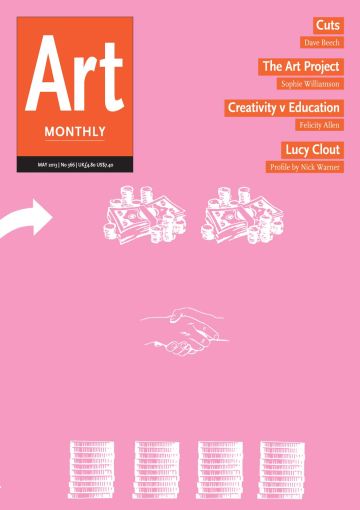Polemic
Disrupting Art Education
David Barrett on the future of the art education market
It was New Labour that began the transformation of higher education into a consumer market with its introduction of tuition fees in 1998, but it was the 2010 Browne Review, produced by former BP CEO Lord Browne (Artnotes AM341) and acted upon by the coalition government in the 2012-13 academic year, that carried the marketisation process to a neoliberal conclusion: allowing universities to set their own tuition fees while at the same time abandoning all state support for arts courses. As a result, art education is now run as a business in a competitive environment in which universities are pitted against each other. More concerning, however, is the fact that individual courses have now been plunged even further into an internal market where they compete for resources within their host universities; courses that do not show a competitive return on investment relative to other programmes are now at risk. Fine art courses, with their expensive studio/workshop requirements, lack of industry sponsorship and limited opportunities to develop patents or intellectual property, look particularly precarious.
Since art education is now a for-profit enterprise, perhaps we ought to ask what kind of market it has become and scrutinise its health through the eyes of the business administrator. If we do so, it becomes clear that this is increasingly a structurally unsound, top-heavy market: entry-level courses are shrinking and postgraduate study is expanding. The rise of the practice-based fine art PhD is emblematic of this, as universities increasingly focus on postgraduate courses, which are often more cost effective in terms of staff and space resources, and research-degree programmes, which are still eligible for grants from the Arts & Humanities Research Council’s annual £100m budget. Conversely, over recent years it was no surprise that foundation courses were cut by universities when financial managers noted that such courses were defined by the state as further education rather than higher education – and thus only attracted state support at further-education rates despite the fact that universities paid their staff the more costly higher-education teaching rates. This worrying shift in emphasis towards the high end comes at a time when the cost of starting out in fine art education has become dauntingly high, inevitably resulting in fewer new students coming through to eventually fill those swelling top-level courses. The traditional pyramid structure of education, with a vast swathe of foundation students filtering through to ever-narrowing groupings of BA, MA and PhD students, is being turned on its head. Over-delivering towards the top end while under-serving at the base – surely that is not sustainable in business terms?
Clayton M Christensen, a Harvard business professor, has since the mid-1990s been developing a theory that specifically addresses established markets that over-deliver. In defining what he calls ‘low-end disruption innovation’, Christensen describes how such markets are swallowed up by new business models that initially appear to offer very little relative to the existing players but gain a foothold by targeting the low end and then quickly expand by improving at a faster rate than their entrenched competitors, eventually surpassing them. The current art education market, which has just had the state’s funding rug pulled from under it, finds itself ripe for just such disruption.
While current university art courses are being reconfigured in the new funding environment, with various parameters – studio space, tutorial time, workshop access etc – being expanded or contracted as dictated by budgets and business models, there remains one cost that these courses cannot avoid: the delivery of a properly validated, internally assessed and internationally recognised qualification. Ironically, this onerous and resource- hungry requirement was previously a prerequisite for state funding but, with the abolition of that very funding, it may have become an albatross around art education’s neck. With resources shrinking, it is likely that universities’ increasingly professionalised artist educators will slowly but surely be incorporated into a bureaucratic system in which a greater percentage of their energies will be spent on course administration in order to maintain validation.
Conversely, by removing the burden of having to offer a qualification – and all its related requirements – there can be a much more efficient use of teaching resources; putting together an art education suddenly seems much simpler. For example, in late 2012 the painting magazine Turps Banana set up its own art school. Essentially, the Turps Art School is a one-year studio placement with some regular tutors and visiting artists, group seminars and crits, and a final exhibition. The fee is £6,000; coincidentally – or not – this is the same as the cut-off point for university courses before they have to contribute towards a national scholarships programme, but it compares favourably to many London university BA art courses which charge the maximum permitted £9,000 per year to UK and EU students, and substantially more to international students (Central Saint Martins: £13,800; Goldsmiths: £16,200; Slade: £19,500). Crucially, Turps Art School does not offer any kind of validation; you do not receive an accredited qualification from the course but you do get a 180sqft studio of your own and the chance to network with the staff of the magazine and other ‘name’ artists.
This is simply one example, however; many more alternative art education models have blossomed in the UK of late, ranging from seminar collectives to summer schools, studio-based projects to reading groups and online programmes: the Islington Mill Art Academy (which offers an n/a rather than an MA), AltMA, Open School East, John Reardon’s Art School UK, Sarah Rowles’s Q-Art, Mirza & Butler’s no.w.here summer school, the Barbican’s Arts School Lab, the Southbank Centre’s Wide Open School, Crate’s Collaborative Research Group, the FACK forum of visual artists, Eastside Project’s Extra Special People associates scheme, Lucky PDF’s School of Global Art, Wysing Arts Centre’s retreats, Banner Repeater’s reading groups etc. With existing courses themselves becoming ever more modularised, why not a pick-n-mix approach to curating a portfolio art education? Whatever it takes, it seems that there is no shortage of individuals and organisations currently experimenting with the various formats that an art education might take.
Whichever model eventually sticks, these programmes are examples of the new business models – if, rather miserably, it is through business models that we must now analyse art education post-Browne Review – that provide many of the education services formerly offered by art schools but without the overheads that validation and university status require. Many of these new models may well be ad hoc at the moment and, arguably, none could currently replace a three-year BA course, but this is exactly how asymmetric disruption begins. And as students ask themselves what £9,000 per academic year – roughly £50/day during term time – will buy them, for better or worse it is likely to be through low-end disruption that new forms of art education will emerge rather than via a top-down tweaking of the existing validated university courses. While the ivory towers are developing corporate glass atria perfectly suited to nurturing post-doctoral hothouse flowers, it may yet be organic growth outside the walled garden of academia that will fuel future generations of artists in the UK.
David Barrett is associate editor of Art Monthly.
First published in Art Monthly 366: May 2013.









